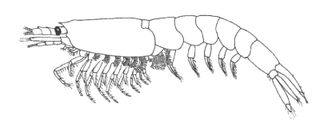 W
WBentheuphausia amblyops, the deep sea krill is a species of krill. B. amblyops is the only species within its genus, which in turn is the only genus within the family Bentheuphausiidae. All the 85 other species of krill known are classified in the family Euphausiidae.
 W
WChrysogorgia elegans is a species of soft coral in the family Chrysogorgiidae. It is found in the Gulf of Mexico, the Mediterranean Sea and the North Atlantic Ocean.
 W
WMolgula occidentalis is a species of marine invertebrate of the family Molgulidae. The scientific name of the species was validated and published for the first time in 1883 by Traustedt. It is a soft-bodied, intertidal ascidian, sac-like filter feeders in the subphylum tunicate characterized by a hard outer covering known as a “tunic,” abundant in the shallow subtidal and intertidal zones of the Northern Gulf of Mexico, where they establish pseudopopulations.
 W
WPhoronis australis is a species of marine horseshoe worm in the phylum Phoronida. It is found in shallow warm-temperate and tropical waters in the eastern Atlantic Ocean and the Indo-Pacific region and was first detected in the Mediterranean Sea in the late twentieth century. These worms live in association with tube-dwelling anemones, particularly those in the genus Cerianthus.
 W
WRhabdastrella globostellata, also known as the yellow pot sponge, is a marine sponge of the order Astrophorida. It is native to many regions of the Indian Ocean including the shores of Madagascar, the Seychelles, and Australia as well as the Malayan Peninsula and Singapore. It was first described by Henry J. Carter as Stelleta globostellata in 1883, named after the globostellate shape of its spicules.
 W
WTrichoplax adhaerens is one of the three named species in the phylum Placozoa. The others are Hoilungia hongkongensis and Polyplacotoma mediterranea. The Placozoa is a basal group of multicellular animals (metazoa). Trichoplax are very flat organisms around a millimetre in diameter, lacking any organs or internal structures. They have two cellular layers: the top epitheloid layer is made of ciliated "cover cells" flattened toward the outside of the organism, and the bottom layer is made up of cylinder cells that possess cilia used in locomotion, and gland cells that lack cilia. Between these layers is the fibre syncytium, a liquid-filled cavity strutted open by star-like fibres.
 W
WTurritopsis dohrnii, also known as the immortal jellyfish, is a species of small, biologically immortal jellyfish found worldwide in temperate to tropic waters. It is one of the few known cases of animals capable of reverting completely to a sexually immature, colonial stage after having reached sexual maturity as a solitary individual. Others include the jellyfish Laodicea undulata and species of the genus Aurelia.